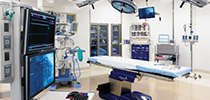Read about the advanced therapies performed for heart rhythm disorders at Oklahoma Heart Hospital and stay connected with the Heart Rhythm Institute.
Heart Rhythm Institute Blog
Posted on October 10th, 2017
Heart block is an abnormal heart rhythm where the heart beats too slowly, which results in the electrical signals being partially or totally blocked between the upper chambers (atria) and lower chambers (ventricles). Heart block is also called atrioventricular (AV) block.
Each heartbeat originates in the upper right chamber (atrium) of the heart in the sinus node, a bundle of specialized... Read More
Posted on September 16th, 2017
The pericardium consists of two thin layers of tissue surrounding the heart that help hold the heart in place and help it function. There is a small amount of fluid between the two layers of tissue to prevent friction.
Pericarditis is inflammation of the pericardium, which can be either acute or chronic. The most common symptom for acute pericarditis is sharp, stabbing pain in the chest,... Read More
Posted on September 11th, 2017
Cardiac implantable electronic devices (CIEDs) such as pacemakers and defibrillators can be life-saving devices for many patients with irregular heart rhythms. But as with any device or implant, there is also a small risk of complications associated with the device. The most common issues are infection or mechanical failure of the device or the leads that attach to the heart.
The risk of... Read More
Posted on August 20th, 2017
There are times when a patient experiences some degree of cardiac symptoms in their daily life but an in-office exam and electrocardiogram (ECG) don’t show any problems.
In situations like these, your heart specialist may recommend one of several types of stress test, which helps measure how your heart and blood vessels respond to physical exertion, whether true physical exertion or... Read More
Posted on August 10th, 2017
Cardiomyopathy is a disease of the heart muscle in which it becomes enlarged, thick, or rigid. As it progresses, the heart weakens and cannot adequately pump blood through the body, which can lead to irregular heart rhythms and heart failure.
This disease can develop over time as a result of other factors or can be genetic. The cause of cardiomyopathy is often unknown, and it can affect all... Read More
Posted on August 2nd, 2017
An MRI, or magnetic resonance imaging, is frequently used to diagnose a range of health issues. An MRI is the best possible diagnostic test for soft tissue disorders. This includes brain disorders, such as stroke or tumors, along with back and spine disorders. MRI is frequently used by orthopedic surgeons to examine joints. Ear, nose, and throat specialists prefer MRI to examine sinuses and... Read More
Posted on July 6th, 2017
An ultrasound is a specific imaging tool used to diagnose and monitor a wide range of health conditions, including everything from pregnancy to tendon damage to heart disease. A probe that emits ultrasound beams is used to capture real-time images on a screen. Unlike x-rays or CT scans, there is no radiation involved in an ultrasound.
At the Oklahoma Heart Hospital, there are two primary... Read More
Posted on June 15th, 2017
The carotid arteries are the blood vessels on either side of the neck that primarily deliver blood to the brain. Carotid artery disease, also called carotid artery stenosis, occurs when these arteries become narrow due to the buildup of fatty substances and cholesterol deposits, which are commonly called plaque. As this plaque builds over time, it can restrict blood flow to the brain, which may... Read More
Posted on June 1st, 2017
Long QT syndrome is a genetic condition that affects the heart’s electrical system. About 1 in 2500 people in the United States have some form of Long QT syndrome, which can cause cardiac arrest if untreated.
Long QT syndrome is caused by a defect in the ion channels (potassium, sodium, calcium, or chloride) in the heart. An ion channel defect means the heart doesn’t recharge... Read More
Posted on May 15th, 2017
A stroke is a loss of blood supply to the brain, either through a blocked artery or a broken artery that causes bleeding. Stroke is the second leading cause of death worldwide.
Stroke risk generally increases for older individuals due to weakening of the artery walls, but stroke can affect anyone. A buildup of plaque in the arteries can break lose and cause a blockage, an aneurysm can... Read More














